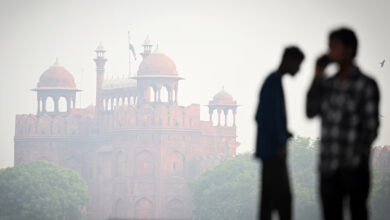
DHAKA, Bangladesh (AP) — When the Dharala River burst its banks in early July, Kamal Hossain left his home with five members of his family to take shelter in a school in northern Bangladesh, carrying their most prized belongings: cattle, a few sacks of rice and clothes.
Like him, an estimated 17.5 million people across South Asia are suffering as a result of the devastation of this year’s monsoon floods. Nearly 700 have died.
A third of Bangladesh went underwater, including Hossain’s district of Kurigram, after most of its 16 rivers overflowed following torrential rains and violent onrush of waters from upstream India, which was also tormented by the floods as rivers cut their ways from as far as the Himalayan nation of Nepal. Bangladesh, which is crisscrossed by 230 rivers, is the last channel through which waters are drained into the Bay of Bengal.
Experts have long been warning that a densely populated delta country like Bangladesh is one of the worst victims of climate change, and severe and frequent floods indicate that something has gone wrong.
“The current major floods affecting millions of people in Bangladesh along with super cyclone Amphan that hit the country a few months ago are both linked to human induced climate now becoming a reality,” said Saleemul Huq, a Bangladeshi expert on climate change and director of the International Center for Climate Change and Development.
He said Bangladesh needs to ramp up its diplomacy to convince global powers to reduce their greenhouse gas emissions as many countries had agreed in the Paris Agreement on Climate Change in 2015.
The impact of global warming in South Asia is evident by a steady sea level rise, changes in ambient temperature and rainfall patterns and an increase in cyclonic activity, experts say. More landslides and flooding are projected across the region, which is home to almost one-fourth of the world’s population. Thousands have already been displaced from low-lying islands in the Sundarbans, the world’s largest mangrove forest straddling Bangladesh and India.
When upstream countries like India or Nepal flush out waters, a district like Kurigram pays the price.
“Some 300,000 people have either lost their homes or crops. Some 400 small river islands were completely under water,” said Mohammed Rezaul Karim, a top government official in Kurigram. “This is a great worry for us.”
Azmat Ulla, the Bangladesh head of the International Federation of Red Cross and Red Crescent Societies, said disasters like floods are becoming more frequent and dangerous.
“Waters are going down, but people’s homes and other infrastructures are being devoured by river erosion,” he said. “Rebuilding their lives is not so easy.”
While the national governments are assessing the extent of damage, the European Union said this week it will provide US$1.94 million in aid. The support comes on top of the $2.21 million announced earlier this year to support those affected by a series of disasters, including Cyclone Amphan that ravaged India and Bangladesh in May.
In Nepal, a repeat of the deadly 1993 floods that were caused by the biggest rainfall on record could be catastrophic, said Shreekamal Dwivedi, a senior engineering geologist at the government’s Venerable Landslides Management Project.
Authorities in one of India’s worst-hit states are also counting losses.
About 5.7 million out of Assam’s 30 million people have been hit by the deluge with the total loss of property and crops estimated at $306 million. Assam faces floods every year when waters of the Brahmaputra, one of Asia’s largest rivers that originates in the Tibetan Himalayas, and its tributaries overflow.
After more than 1.5 months in shelter, Hossain is preparing to return home, but faces uncertainty over how to rebuild with almost no money in hand. His only choice is to wait for the next harvest two months away.
“I have lost everything. I don’t know what will happen next,” he said.
___
Gurubacharya reported from Kathmandu, Nepal and Hussain from Gauhati, India.
Image: A Bangladeshi elderly person cuts an uprooted tree as the area around him is seen submerged with flooded waters in Manikganj, some 100 kilometers (62 miles) from Dhaka, Bangladesh, Thursday, Aug. 13, 2020. Across South Asia, more than 17 million people have been affected by this year’s monsoon flood. Nearly 700 people have died in Bangladesh, India and Nepal as almost one-third of Bangladesh went under water while Indian states of Assam and Bihar in the northeast were largely affected and vast regions in Nepal were flooded and monsoon-triggered landslides became a nightmare. (AP Photo/Al-emrun Garjon)




